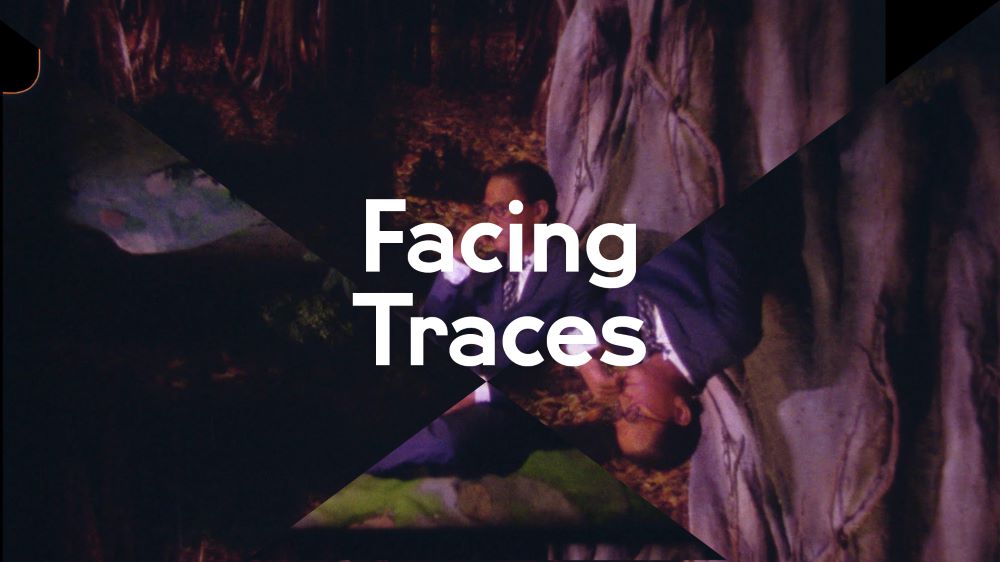Up for Debate: Facing Traces
Up for Debate: Facing Traces

Facing Traces
By Petra Palmer
Suneil Sanzgiri’s essay film begins with the origins of his family: in a 3D animation, one is situated in the mountains of Kashmir. Suneil’s father explains the origin of the family name; the mountain range has inscribed itself in the name of his family. At the edge of the image, a short text conversation via mobile phone between Suneil and his father starts, followed by a performance of the poem they converse about: “Dear Shahid, I am writing to you from your far-off country, far even from us who live here. Where you no longer are.” The Kashmiri poet Aga Shahid Ali, who emigrated to the USA in 1976, wrote this letter in the form of a poem to himself from exile in 1996. The country he describes seems to remain only in the memory, even of those who stayed behind. In this sense, Aga Shahid Ali’s letter seems to be addressed to another time rather than a place.
In his film, Sanzgiri combines events of political resistance at different times and places with biographical facts that become reference points to the present and projections of memory. “What is one’s claim to the past, and how do biography and history collide?” Sanzgiri asks in Letter from Your Far-off Country, taking his year of birth, 1989, as a starting point. Sanzgiri also adopts the epistolary form to write to a distant relative and this letter, too, addresses the past — the addressee is a deceased uncle who was the leader of the communist party. Sanzgiri’s father reads the letter aloud, carrying the story out of his own person. The letters, in their displacement, are anonymous testimony, and at the same time they give the reassurance of hearing one’s own voice through the voice of another.
The occurrences and changes since Suneil Sanzgiri’s birth are coordinates that are connected and become a space of orientation. How do these events affect one’s own life? What traumas are transmitted through family and what are their points of reference? What does the search for traces in one’s family mean for one’s own position, and how is this perspective placed in relation to history? It is not only in film that gaps remain between the events shown and between the letters and the voices; in biographies and history, there is also a need to establish coherence and causality. How does one’s own subjectivity emerge in relation to the past, and how strongly is one determined by it? Or can one re-construct the narrative of the past, and what does this mean for the future? How we connect, how we comprehend is up to us. How do we face the disruption of linearity, and how can history be read? These are all questions that go beyond Suneil Sanzgiri’s essay film and biography.
Traces are imprints, a proof of something that existed but of which only the vague evidence of existence remains. In Francina Carbonell’s The Sky Is Red, we also search in vain for evidence in the images. The film tries to reconstruct the devastating fire in the San Miguel prison in Santiago, Chile, in which 81 people died. What traces can be found in the footage from the prison’s surveillance cameras, whose automatic recording of images mostly happened at random? The cameras run continuously and record everything, only to show a blank space instead of the proof of evidence at the decisive moment.
What do these blank spaces show, and what knowledge can we gain beyond the material that is revealed and shown? The blank spaces are reconstructed in the film with re-enactments and interviews with eyewitnesses. Then at some point you hear the voices, the screams recorded from inside the building at the time of the disaster. These make the evidence of the incident almost unbearable, and real, substantiating the indescribable. The memory of the witnesses fades: some want to forget, to repress, others revise their statements, and unexplained blanks remain.
In literature there is a difference between blank spaces and spaces of indeterminacy. What do they mean for biographies, historical narratives, or an incident like the prison fire? How can these spaces be read and are they intentionally left blank. What are the implications for these voids and what consequences do they have for what could be the truth? The absence of traces interrupts the coherence of a text and yet produces the narrative. In Letter from Your Far-off Country the everyday myths — or in the case of The Sky Is Red, resignation over a catastrophe that will not be cleared up.
A video of the debate can be found here.
